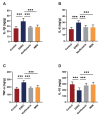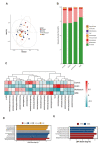Pediococcus pentosaceus IM96 Exerts Protective Effects against Enterohemorrhagic Escherichia coli O157:H7 Infection In Vivo
- PMID: 34945495
- PMCID: PMC8700651
- DOI: 10.3390/foods10122945
Pediococcus pentosaceus IM96 Exerts Protective Effects against Enterohemorrhagic Escherichia coli O157:H7 Infection In Vivo
Abstract
Enterohemorrhagic Escherichia coli (EHEC) is a notorious and prevalent foodborne pathogen which can cause serious intestinal diseases. The antagonistic activity of probiotics against EHEC is promising, but most of the studies concerning this subject have been carried out in vitro. Specifically, the interaction between Pediococcus pentosaceus and EHEC O157:H7 in vivo has not been reported yet. In this study, we investigated the protective effect of P. pentosaceus IM96 on EHEC O157:H7-infected female mice in vivo. The results demonstrated that P. pentosaceus IM96 reduced the level of pro-inflammatory factors and increased the level of anti-inflammatory factors of EHEC O157:H7-infected mice. Furthermore, P. pentosaceus IM96 alleviated intestinal mucosal damage and increased the level of MUC-2, tight junction (TJ) proteins, and short chain fatty acids (SCFAs). The intestinal microbial community structure and the diversity and richness of the microbiota were also changed by P. pentosaceus IM96 treatment. In summary, P. pentosaceus IM96 exerted protective effects against EHEC O157:H7 via alleviating intestinal inflammation, strengthening the intestinal barrier function, and regulating intestinal microbiota, suggesting that P. pentosaceus IM96 might serve as a potential microbial agent to prevent and treat intestinal diseases caused by EHEC O157:H7 infection in the future.
Keywords: EHEC O157:H7; Pediococcus pentosaceus IM96; inflammation; intestinal barrier; intestinal microbiota; probiotics.
Conflict of interest statement
The authors declare no competing interests.
Figures







Similar articles
-
Human cathelicidin LL-37 exerts amelioration effects against EHEC O157:H7 infection regarding inflammation, enteric dysbacteriosis, and impairment of gut barrier function.Peptides. 2023 Jan;159:170903. doi: 10.1016/j.peptides.2022.170903. Epub 2022 Nov 9. Peptides. 2023. PMID: 36370932
-
Bacillus amyloliquefaciens TL106 protects mice against enterohaemorrhagic Escherichia coli O157:H7-induced intestinal disease through improving immune response, intestinal barrier function and gut microbiota.J Appl Microbiol. 2021 Jul;131(1):470-484. doi: 10.1111/jam.14952. Epub 2020 Dec 18. J Appl Microbiol. 2021. PMID: 33289241
-
Cathelicidin- derived PR39 protects enterohemorrhagic Escherichia coli O157:H7 challenged mice by improving epithelial function and balancing the microbiota in the intestine.Sci Rep. 2019 Jul 1;9(1):9456. doi: 10.1038/s41598-019-45913-6. Sci Rep. 2019. PMID: 31263234 Free PMC article.
-
Escherichia coli O157:H7: animal reservoir and sources of human infection.Foodborne Pathog Dis. 2011 Apr;8(4):465-87. doi: 10.1089/fpd.2010.0673. Epub 2010 Nov 30. Foodborne Pathog Dis. 2011. PMID: 21117940 Free PMC article. Review.
-
A Toxic Environment: a Growing Understanding of How Microbial Communities Affect Escherichia coli O157:H7 Shiga Toxin Expression.Appl Environ Microbiol. 2020 Nov 24;86(24):e00509-20. doi: 10.1128/AEM.00509-20. Print 2020 Nov 24. Appl Environ Microbiol. 2020. PMID: 32358004 Free PMC article. Review.
Cited by
-
Assessing the Probiotic Effects of Pediococcus pentosaceus CACC616 in Weaned Piglets.Microorganisms. 2023 Nov 30;11(12):2890. doi: 10.3390/microorganisms11122890. Microorganisms. 2023. PMID: 38138034 Free PMC article.
-
Dissecting of the AI-2/LuxS Mediated Growth Characteristics and Bacteriostatic Ability of Lactiplantibacillus plantarum SS-128 by Integration of Transcriptomics and Metabolomics.Foods. 2022 Feb 22;11(5):638. doi: 10.3390/foods11050638. Foods. 2022. PMID: 35267271 Free PMC article.
-
Probiotic characteristics and whole genome sequencing of Pediococcus pentosaceus SNF15 and its protective effect on mice diarrhea induced by Escherichia coli K99.Front Vet Sci. 2025 Mar 13;12:1524658. doi: 10.3389/fvets.2025.1524658. eCollection 2025. Front Vet Sci. 2025. PMID: 40151573 Free PMC article.
-
Antihypertensive Activity of Milk Fermented by Lactiplantibacillus plantarum SR37-3 and SR61-2 in L-NAME-Induced Hypertensive Rats.Foods. 2022 Aug 4;11(15):2332. doi: 10.3390/foods11152332. Foods. 2022. PMID: 35954098 Free PMC article.
-
Microbiome composition and presence of cultivable commensal groups of Southern Tamanduas (Tamandua tetradactyla) varies with captive conditions.Anim Microbiome. 2024 May 2;6(1):21. doi: 10.1186/s42523-024-00311-w. Anim Microbiome. 2024. PMID: 38698458 Free PMC article.
References
-
- Browne A.J., Kashef Hamadani B.H., Kumaran E.A.P., Rao P., Longbottom J., Harriss E., Moore C.E., Dunachie S., Basnyat B., Baker S., et al. Drug-resistant enteric fever worldwide, 1990 to 2018: A systematic review and meta-analysis. BMC Med. 2020;18:1. doi: 10.1186/s12916-019-1443-1. - DOI - PMC - PubMed
Grants and funding
- 2018B020205002/Key-Area Research and Development Program of Guangdong Province
- 2019QN01N107/Project by the Department of Science and Technology of Guangdong Province
- 2020B121201009/Key Laboratory of Guangdong Province
- 2020GDASYL-20200301002/Guangdong Province Academy of Sciences Special Project for Capacity Building of Innovation Driven Development
LinkOut - more resources
Full Text Sources
Molecular Biology Databases
Miscellaneous

